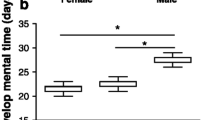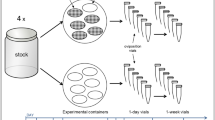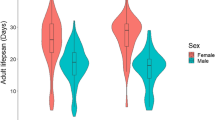Abstract
Life history characteristics and resulting fitness consequences manifest not only in an individual experiencing environmental conditions but also in its offspring via trans-generational effects. We conducted a set of experiments to assess the direct and trans-generational effects of food deprivation in the Glanville fritillary butterfly Melitaea cinxia. Food availability was manipulated during the final stages of larval development and performance was assessed during two generations. Direct responses to food deprivation were relatively minor. Food-deprived individuals compensated, via increased development time, to reach a similar mass as adults from the control group. Delayed costs of compensatory growth were observed, as food-deprived individuals had either reduced fecundity or lifespan depending on the type of feeding treatment they had experienced (intermittent vs. continuous). Female food deprivation did not directly affect her offspring’s developmental trajectory, but the way the offspring coped with food deprivation. Offspring of mothers from control or intermittent starvation treatments reached the size of those in the control group via increased development time when being starved. In contrast, offspring of mothers that had experienced 2 days of continuous food deprivation grew even larger than control animals, when deprived of food themselves. Offspring of food-deprived Glanville fritillary initially showed poor immune response to parasitism, but not later on in development.



Similar content being viewed by others
References
Agrawal AA (2002) Herbivory and maternal effects: mechanisms and consequences of transgenerational induced plant resistance. Ecology 83:3408–3415
Agrawal AA, Laforsch C, Tollrian R (1999) Transgenerational induction of defenses in animals and plants. Nature 401:60–63
Alleyne M, Wiedenmann RN (2001) Encapsulation and hemocyte numbers in three lepidopteran stemborers parasitized by Cotesia flavipes-complex endoparasitoids. Entomol Exp Appl 100:279–293
Baldal EA, Brakefield PM, Zwaan BJ (2006) Multitrait evolution in lines of Drosophila melanogaster selected for increased starvation resistance: the role of metabolic rate and implications for the evolution of longevity. Evolution 60:1435–1444
Barrett ELB, Hunt J, Moore AJ, Moore PJ (2009) Separate and combined effects of nutrition during juvenile and sexual development on female life-history trajectories: the thrifty phenotype in a cockroach. Proc R Soc Lond B 276:3257–3264
Bashey F (2006) Cross-generational environmental effects and the evolution of offspring size in the Trinidadian guppy Poecilia reticulata. Evolution 60:348–361
Bauer E, Trenczek T, Dorn S (1998) Instar-dependent hemocyte changes in Pieris brassicae after parasitization by Cotesia glomerata. Entomol Exp Appl 88:49–58
Bauerfeind SS, Fischer K (2005a) Effects of adult-deprived carbohydrates, amino acids and micronutrients on female reproduction in a fruit-feeding butterfly. J Insect Physiol 51:545–554
Bauerfeind SS, Fischer K (2005b) Effects of food stress and density in different life stages on reproduction in a butterfly. Oikos 111:514–524
Beckage NE, Thompson SA, Federici BA (eds) (1993) Parasites and pathogens of insects. Academic, New York
Bishop NA, Guarente L (2007) Genetic links between diet and lifespan:shared mechanisms from yeast to humans. Nat Rev Genet 8:835–844
Boggs CL (2009) Understanding insect life histories and senescence through a resource allocation lens. Funct Ecol 23:27–37
Boggs CL, Freeman KD (2005) Larval food limitation in butterflies: effects of adult resource allocation and fitness. Oecologia 144:353–361
Boggs CL, Ross CL (1993) The effect of adult food limitation on the life-history traits in Speyeria mormonia (Lepidoptera: Nymphalidae). Ecology 74:433–441
Bradshaw AD (1965) Evolutionary significance of phenotypic plasticity in plants. Adv Genet 13:115–155
Bukovinszky T et al (2009) Consequences of constitutive and induced variation in plant nutritional quality for immune defence of a herbivore against parasitism. Oecologia 160:299–308
Criscuolo F, Monaghan P, Nasir L, Metcalfe NB (2008) Early nutrition and phenotypic development: “catch-up” growth leads to elevated metabolic rate in adulthood. Proc R Soc Lond B 275:1565–1570
Dmitriew C, Rowe L (2007) Effects of early resource limitation and compensatory growth on lifetime fitness in the ladybird beetle (Harmonia axyridis). J Evol Biol 20:1298–1310
Dmitriew C, Rowe L (2011) The effects of larval nutrition on reproductive performance in a food-limited adult environment. PLoS One 6:e17399
Esperk T, Tammaru T (2010) Size compensation in moth larvae: attention to larval instars. Physiol Entomol 35:222–230
Fox CW, Mousseau TA (1998) Maternal effects as adaptations for transgenerational phenotypic plasticity in insects. In: Mousseau TA, Fox CW (eds) Maternal effects as adaptations. Oxford University Press, New York, pp 159–177
Fox CW, Czesak ME, Savalli UM (1999) Environmentally-based maternal effects on development time in the seed beetle, Stator pruininus (Coleoptera: Bruchidae): consequences of larval density. Environ Entomol 28:217–223
Garcia-Barros E (2000) Body size, egg size, and their interspecific relationships with ecological and life history traits in butterflies (Lepidoptera: Papilionoidea, Hesperioidea). Biol J Linn Soc 70:251–284
Ghalambor CK, McKay JK, Carroll SP, Reznick DN (2007) Adaptive versus non-adaptive phenotypic plasticity and the potential for contemporary adaptation in new environments. Funct Ecol 21:394–407
Gillespie JP, Kanost MR, Trenczek T (1997) Biological mediators of insect immunity. Annu Rev Entomol 42:611–643
Hafer N, Ebil S, Uller T, Pike N (2011) Transgenerational effects of food availability on age at maturity and reproductive output in an asexual collembolan species. Biol Lett 7:755–758
Hanski I, Meyke E (2005) Large-scale dynamics if the Glanville fritillary butterfly: landscape structure, population processes, and weather. Ann Zool Fenn 42:379–395
Hanski I, Saastamoinen M, Ovaskainen O (2006) Dispersal-related life history trade-offs in a butterfly metapopulation. J Anim Ecol 75:91–100
Harbison ST, Chang S, Kamdar KP, Mackay TFC (2005) Quantitative genomics of starvation stress resistance in Drosophila. Genome Biol 6:R36
Hector KL, Nakagawa S (2012) Quantitative analysis of compensatory and catch-up growth in diverse taxa. J Anim Ecol. doi:10.1111/j.1365-2656.2011.01942.x
Helle H, Koskela E, Mappes T (2012) Life in varying environments: experimental evidence for delayed effects of juvenile environment on adult life history. J Anim Ecol. doi:10.1111/j.1365-2656.2011.01937.x
Hellmann J (2002) The effect of an environmental change on mobile butterfly larvae and the nutritional quality of their hosts. J Anim Ecol 71:925–936
Jimenez-Perez A, Wang Q (2004) Effect of body weight on reproductive performance in Cnephasia jactatana (Lepidoptera: Tortricidae). J Insect Behav 17:511–522
Kankare M, Stefanescu C, Van Nouhuys S, Shaw MR (2005) Host specialization by Cotesia wasps (Hymenoptera: Braconidae) parasitizing species-rich Melitaeini (Lepidoptera: Nymphalidae) communities in north-eastern Spain. Biol J Linn Soc 86:45–65
Krug P, Zimmer R (2000) Developmental dimorphism: consequences for larval behavior and dispersal potential in a marine gastropod. J Exp Biol 203:1741–1754
Kuussaari M, Singer M, Hanski I (2000) Local specialization and landscape-level influence on host use in a herbivorous insect. Ecology 81:2177–2187
Kuussaari M, van Nouhuys S, Hellmann J, Singer M (2004) Larval biology. In: Ehrlich PR, Hanski I (eds) On the wings of checkerspots: a model system for population biology. Oxford University Press, Oxford, pp 138–160
Lackie AM (1988) Haemocyte behavior. Adv Insect Physiol 21:85–178
Laurentz M, Reudler JH, Mappes J, Friman V, Ikonen S, Lindstedt C (2012) Diet quality can play a critical role in defence efficacy against parasitoids and pathogens in the Glanville fritillary (Melitaea cinxia). J Chem Ecol 38(1):116–125
Lavine MD, Strand MR (2002) Insect hemocytes and their role in immunity. Insect Biochem Mol Biol 32:1295–1309
Lei GC, Vikberg V, Nieminen M, Kuussaari M (1997) The parasitoid complex attacking the Finnish populations of Glanville fritillary Melitaea cinxia (Lep: Nymphalidae), an endangered butterfly. J Nat Hist 31:635–648
Liefting M, Hoffmann AA, Ellers J (2009) Plasticity versus environmental canalization: population differences in thermal responses along a latitudinal gradient in Drosophila serrata. Evolution 63:1954–1963
Lopez-Maury L, Marguerat S, Bähler J (2008) Tuning gene expression to changing environments: from rapid responses to evolutionary adaptation. Nat Rev Genet 9:583–593
Marshall DJ (2008) Transgenerational plasticity in the sea: context-dependent maternal effects across the life history. Ecology 89:418–427
Marshall DJ, Uller T (2007) When is a maternal effect adaptive? Oikos 116:1957–1963
McNamara JM, Houston AI (1996) State-dependent life histories. Nature 380:215–221
Metcalfe NB, Monaghan P (2001) Compensation for a bad start: grow now, pay later? Trends Ecol Evol 16:254–260
Meyers LA, Bull JJ (2002) Fighting change with change: adaptive variation in an uncertain world. Trends Ecol Evol 17:551–557
Monaghan P (2008) Early growth conditions, phenotypic development and environmental change. Philos Trans R Soc Lond B 363:1635–1645
Monaghan P, Heidinger BJ, D’Alba L, Evans NP, Spencer KA (2011) For better or worse: reduced adult lifespan following early-life stress is transmitted to breeding partners. Proc R Soc Lond B 279:709–714
Moret Y, Schmid-Hempel P (2000) Survival for immunity: the price of immune system activation for bumblebee workers. Science 290:1166–1168
Mousseau TA, Dingle H (1991) Maternal effects in insect life histories. Annu Rev Entomol 36:511–534
Mousseau TA, Fox CW (1998) The adaptive significance of maternal effects. Trends Ecol Evol 13:403–407
O’Brien DM, Boggs CL, Fogel ML (2004) Making eggs from nectar: the role of life history and dietary carbon turnover in butterfly reproductive resource allocation. Oikos 105:279–291
Okech SHO, Overholt WA (1996) Comparative biology of Cotesia chilonis (Hymenoptera: Braconidae) on selected African gramineous stemborers. Biocontrol Sci Technol 6:595–602
Pachauri RK, Reisinger A (eds) (2007) IPCC, Climate change 2007: synthesis report. Contribution of Working Groups I, II and III to the Fourth Assessment Report of the Intergovernmental Panel on Climate Change, IPCC, Geneva, Switzerland
Pakarinen S (2011) Host-parasitoid relationship in different Cotesia melitaearum and Melitaea cinxia populations around the Baltic Sea. MSc thesis, University of Helsinki, Helsinki
Parsons PA (1993) Evolutionary adaptations and stress: energy budgets and habitats preferred. Behav Genet 23:231–238
Pigliucci M (2001) Phenotypic plasticity: beyond nature and nurture. Johns Hopkins University Press, Baltimore
Rantala MJ, Roff DA (2005) An analysis of trade-offs in immune function, body size and development time in the Mediterranean Field Cricket, Grylluis bimaculatus. Funct Ecol 19:323–330
Räsänen K, Kruuk LEB (2007) Maternal effects and evolution at ecological time-scales. Funct Ecol 21:408–421
Saastamoinen M (2007) Life-history, genotypic, and environmental correlates of clutch size in the Glanville fritillary butterfly. Ecol Entomol 32:235–242
Saastamoinen M, van Nouhuys S, Nieminen M, O’Hara B, Suomi J (2007) Development and survival of a specialist herbivore, Melitaea cinxia, on host plants producing high and low concentrations of iridoid glycosides. Ann Zool Fenn 44:70–80
Saastamoinen M, Ikonen S, Hanski I (2009) Significant effects of Pgi genotype and body reserves on lifespan in the Glanville fritillary butterfly. Proc R Soc Lond B 276:1313–1322
Saastamoinen M, van der Sterren D, Vastenhout N, Zwaan BJ, Brakefield PM (2010) Predictive adaptive responses: condition-dependent impact of adult nutrition and flight in the tropical butterfly Bicyclus anynana. Am Nat 176:686–698
Salinas S, Munch SB (2011) Thermal legacies: transgenerational effects of temperature on growth in a vertebrate. Ecol Lett 15:159–163
Schmid-Hempel P (2003) Variation in immune defence as a question of evolutionary ecology. Proc R Soc Lond B 270:357–366
Schmidt O, Theopold U, Strand M (2001) Innate immunity and its evasion and suppression by hymenopteran endoparasitoids. Bioessays 23:344–351
Strand MR (2008) The insect cellular immune response. Insect Sci 15:1–14
van Nouhuys S, Hanski I (2005) Metacommunities of butterflies, their host plants and their parasitoids. In: Holyoak M, Leibold MA, Holt RD (eds) Metacommunities: spatial dynamics and ecological communities. University of Chicago Press, Chicago, pp 99–121
van Nouhuys S, Laine A-L (2008) Population dynamics and sex ratio of a parasitoid altered by fungal-infected diet of host butterfly. Proc R Soc Lond B 275:787–795
van Nouhuys S, Lei GC (2004) Parasitoid-host metapopulation dynamics: the causes and consequences of phenological asynchrony. J Anim Ecol 73:526–535
van Nouhuys S, Punju E (2010) Coexistence of competing parasitoids: which is the fugitive and where does it hide? Oikos 119:61–70
van Nouhuys S, Singer M, Nieminen M (2003) Spatial and temporal patterns of caterpillar performance and the suitability of two host plant species. Ecol Entomol 28:193–202
Vet LEM, Lewis WJ, Papaj DR, van Lenteren JC (1990) A variable response model for parasitoid foraging behavior. J Insect Behav 31:471–490
Vinson SB (1976) Host selection by insect parasitoids. Annu Rev Entomol 21:109–134
Yoder JA, Tank JL, Rellinger EJ (2006) Evidence of a maternal effect that protects against water stress in larvae of the American dog tick, Dermacentor variabilis (Acari: Ixodidae). J Insect Physiol 52:1034–1042
Acknowledgments
We would like to acknowledge Lea Heikkinen, Terhi Lahtinen, Linda Peltola and Suvi Ikonen for their assistance in the experiments. We thank Ilkka Hanski, Klaus Fischer, and two anonymous referees for their useful comments on the manuscript. This research was funded by the Academic Academy of Finland Grants (Nos. 132697 to M.S., and 213547 and 130958 to S.v.N.) and by the European Research Council Advanced Grant (232826 to I. Hanski).
Author information
Authors and Affiliations
Corresponding author
Additional information
Communicated by Klaus Fischer.
Electronic supplementary material
Below is the link to the electronic supplementary material.
Rights and permissions
About this article
Cite this article
Saastamoinen, M., Hirai, N. & van Nouhuys, S. Direct and trans-generational responses to food deprivation during development in the Glanville fritillary butterfly. Oecologia 171, 93–104 (2013). https://doi.org/10.1007/s00442-012-2412-y
Received:
Accepted:
Published:
Issue Date:
DOI: https://doi.org/10.1007/s00442-012-2412-y




